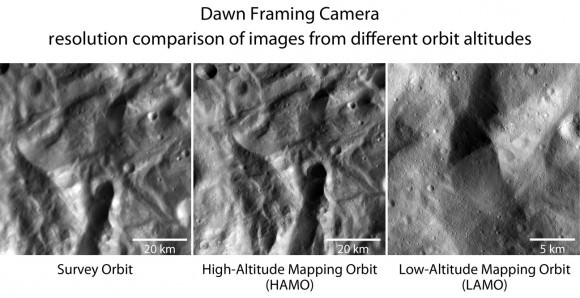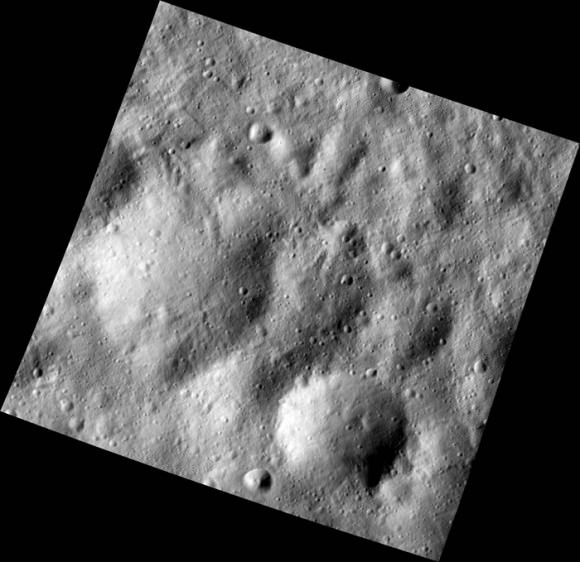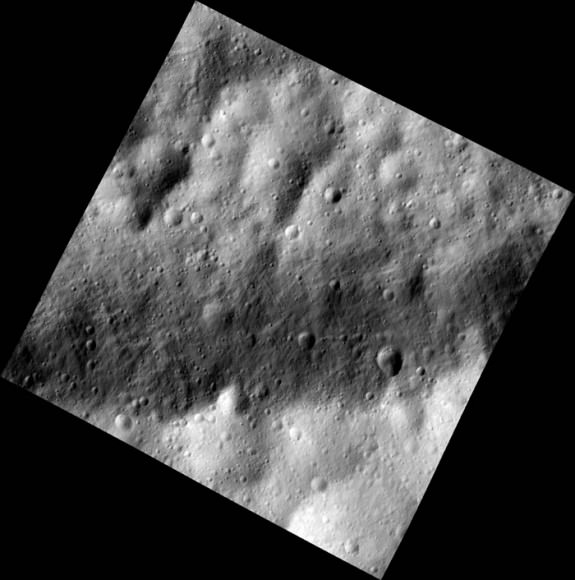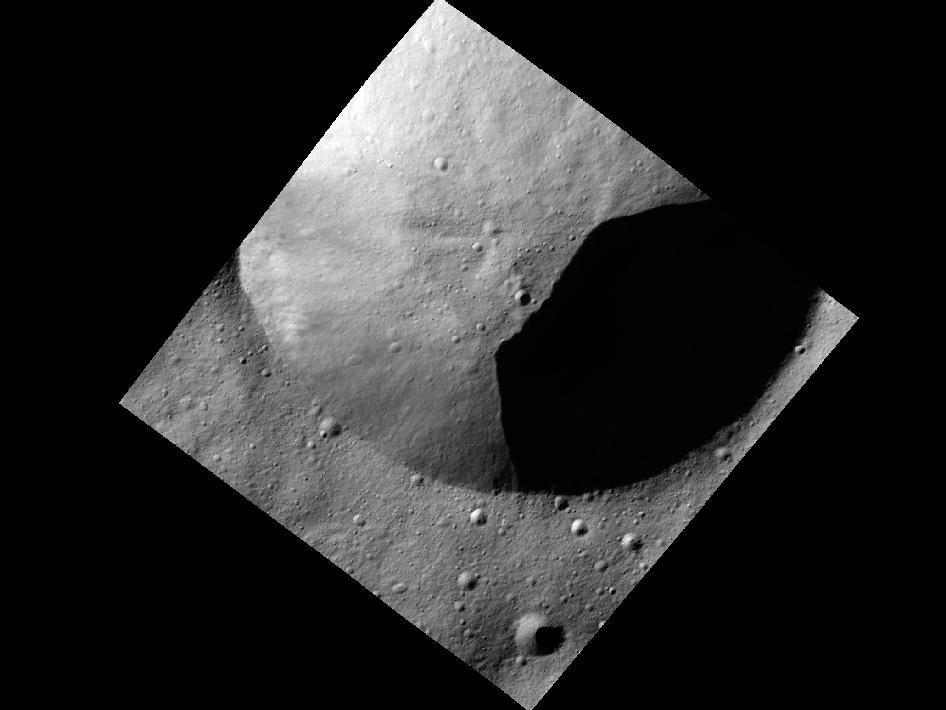[/caption]
NASA’s Dawn spacecraft has swooped down to the closest orbit above the monster asteroid Vesta that the craft’s cameras and spectrometers will ever glimpse and the probe has begun transmitting these highest resolution pictures to anxiously waiting scientists back on Earth.
Dawn arrived at its Low Altitude Mapping Orbit, known as LAMO, on Dec. 12, 2011 and will continue circling scarcely 130 miles (210 kilometers) above Vesta for at least the next 10 weeks. Each orbit takes about 4.3 hours.
NASA has now released the first batch of crisp new close-ups images taken by the Framing Camera on Dec. 13 showing the stippled and lumpy surface in an exquisitely fine detail never seen before.
The photo montage below shows side by side views of the same portion of the Vestan surface at ever increasing resolution and clarity from ever lower altitudes.

NASA’s Dawn spacecraft has spiraled closer and closer to the surface of the giant asteroid Vesta since arriving in mid-2011. The two images on the left represent an identical area, first observed during Dawn's survey orbit (far left image). The picture in the center is from Dawn's high-altitude mapping orbit (HAMO) from an altitude of about 430 miles (700 km) with about 230 feet (70 meters-per-pixel) resolution. The image at right was obtained on Dec. 13 from the low altitude mapping orbit (LAMO) at an altitude of 124 miles (199 km) above the surface and has a resolution of 75 feet (23 m) per pixel. It shows small impact craters or slumping at the steep-flanked mountain in the image center that can be identified in the two images to the left. Credit: NASA/JPL-Caltech/UCLA/MPS/DLR/IDA
The high resolution image gallery reveals fine scale highlights such as multitudes of small craters, grooves and lineaments, landslides and slumping, ejecta from past colossal impacts, and small outcrops of bright and dark materials.
The science team, led by Principal Investigator Prof Chris Russell of UCLA, believes that Vesta is actually more like a planet than an asteroid based on the data obtained thus far.
“Vesta is the smallest terrestrial planet in our Solar System”, Russell told Universe Today. “We do not have a good analog to Vesta anywhere else in the Solar System.”
The primary science objectives at the LAMO orbit are to measure the elemental abundances on the surface of Vesta with the US built gamma ray and neutron detector (GRaND) and to probe the interior structure of the asteroid by measuring the gravity field.
Vesta is a proto-planet formed just a few million years after the birth of the solar system whose evolution into a larger planet was stopped cold by the massive gravitational influence of the planet Jupiter.
Scientists are plowing through thousands of images and millions of spectral measurements to glean clues about the origin and evolution of the solar system that have been preserved on the hitherto unexplored world.

This Dec. 13 image from Dawn spacecraft in its low altitude mapping orbit shows many buried craters located within the equatorial trough region of Vesta. This area bears traces of the material thrown out by the impact that created the Rheasilvia basin in the asteroid’s south polar region. Lineated features are visible in a variety of shapes and sizes from an altitude of 117 miles (189 km) over an area of 11 mi x 11 mi (18 km x 18 km). Credit: NASA/JPL-Caltech/UCLA/MPS/DLR/IDA
“Vesta is a transitional body between a small asteroid and a planet and is unique in many ways,” says mission scientist Vishnu Reddy of the Max Planck Institute for Solar System Research in Katlenburg-Lindau, Germany. “Vesta is unlike any other asteroid we have visited so far.”
After completing the LAMO measurements, Dawn will again spiral back to a higher altitude for further data gathering especially at the unseen North Pole which is in darkness now.
Dawn will continue orbiting Vesta until July 2012 when it will fire up its ion propulsion system and depart for Ceres, the largest body in the main Asteroid belt between Mars and Jupiter.
“What can be more exciting than to explore an alien world that until recently was virtually unknown!” Dr. Marc Rayman told Universe Today. Rayman is Dawn’s Chief Engineer from NASA’s Jet Propulsion Lab (JPL) in Pasadena, Calif.

This image was one of the first obtained by Dawn in its low altitude mapping orbit and shows a part of one of the long troughs at the equator of Vesta. Credit: NASA/ JPL-Caltech/ UCLA/ MPS/ DLR/ IDA
“Dawn continues to gather gamma ray spectra and neutron spectra,” Rayman reports. “The bonus imaging at LAMO is yielding pictures more than three times better than those acquired in the high altitude mapping orbit (HAMO). Every week at this low altitude, Dawn will use its ion propulsion system to fine tune its orbit. The first of these weekly orbit adjustments was performed on December 17.”
The framing cameras eere built by the Max Planck Institute for Solar System Research in Germany.
A treasure trove of spectacular Vesta close-ups are streaming at this moment to the home planet and we’ll have many more goodies to show.
Read continuing features about Dawn by Ken Kremer starting here:
Holiday Greetings from an Alien Snowman on Vesta
Dawn swoops to lowest orbit around Vesta – Unveiling Spectacular Alien World
Rainbow of Colors Reveal Asteroid Vesta as More Like a Planet
Vrooming over Vivid Vestan Vistas in Vibrant 3 D – Video
NASA Planetary Science Trio Honored as ‘Best of What’s New’ in 2011- Curiosity/Dawn/MESSENGER
Dawn Discovers 2nd Giant South Pole Impact Basin at Strikingly Dichotomous Vesta
Amazing New View of the Mt. Everest of Vesta
Dramatic 3 D Imagery Showcases Vesta’s Pockmarked, Mountainous and Groovy Terrain


It’s funny and a little annoying that these pictures are so often oriented with the light coming from below which, because different from our usual perspective, causes us to see the terrain inverted, ie: the craters as bumps and hollows as mountains. I realize these may use N/S coordinates but really, that has little bearing to a non-spherical asteroid tumbling in its orbit. Just saying, as I had to spend 2 minutes on each pic, forcing my brain to see the pic properly.
Yea my mind sees mounds and it’s hard to visualize craters.
What a needless waste of time, eye cones and electric power! It’ll take you only about 10 seconds flat to copy/paste any illustration onto “Word” and then use the “rotate” tool there to turn it upside down (or to stand up, go around, stand behind your computer and look down on the screen from behind, circumstances allowing). All of a sudden the apparent mounds will turn into depressions. I’ve never sat there like a zombie for 120 seconds trying to make the former look like the latter, and I think I could never achieve the feat. What you need to do is to re-structure your procedures, à la perestroika, in order to make them more efficient. In this case efficiency will improve 1,200 percent.
Rotating won’t do it. Load the image in a photo editor and invert the colors. (Instead of “invert”, it may be called “negative.”) If it looked like mounds before, it should look like craters after it is converted.
Rotating won’t do it, so don’t bother with the instructions above…
Since we are dealing with grayscale images here, load the image in a photo editor and invert the colors. (Instead of “invert”, it may be called “negative.”) If the image looked like mounds before, it should look like craters after it is inverted.
If you say placing the image upside down won’t work it’s because you haven’t bothered to try that out, or else it won’t work for some people, for unknown physiological reasons. Maybe it happens to people who use thick eyeglasses, or anyone with severely distorted eyeballs, or if you happen to have lopsided vision??? If it’s in a book or a magazine, turning it around is all you need to do. I’ll see if I can make your method do the trick, but out of mere curiosity since it’s completely unnecessary in my case. I wonder how long it will take to solve this new enigma you suddenly bring out. Thank you for bothering to…horribly confuse the matter!!!
What I describe is a well-known, simple solution to that annoying optical illusion. It permanently solved the problem for me. I read about it and the full explanation somewhere years ago but I can’t remember how it goes. It could be in one of my old astronomy magazines but surely it would take hours to find. I assumed that most people knew about this and that it worked for everybody… and a very Cheerful New Year!
It’s different for me. If I look at a picture like this I expect to see craters, so I see them as craters whichever way the light is shining.
I’m no planetary scientist but I tend to disagree with PI Chris Russell’s assertion that Vesta is more planet-like. I think the hydrostatic equilibrium (round shape) is a good criteria, and that precludes Vesta from being a dwarf planet (let alone a planet). Pictures clearly show significant enough deviation from a spherical shape.
That is an interesting issue. Here it is a slightly different context than the usual.
The question before the mission was if Vesta was differentiated, that is if it had heated enough to form a denser core. It has, as witnessed by the presence of many differentiated surface minerals and, I think, by gravimetric observation. (Indeed, smaller bodies such as Lutetia are now suspected to be differentiated or at least acquired a core somehow.)
That makes Vesta belong to the planetesimals, along with Mars, Mercury and perhaps Ceres. As Mars Vesta was interrupted by Jupiter to aggregate to enough size to retain a sizable atmosphere. Presumably this was what Russell was referring to.
Why that is interesting depends on what it tells us about planet and mineral formation.
The differentiation implies that Vesta was once a body trying to achieve hydrostatic equilibrium. And it seems it had the time to, before it froze sufficiently to not retain spherical shape after later massive impacts (on the same side!).
[Lutetia is AFAIU a remnant of a larger, fragmented body.]
[IVAN]There’s a typo in the second-last paragraph. “eere” -> “were”.[/IVAN]